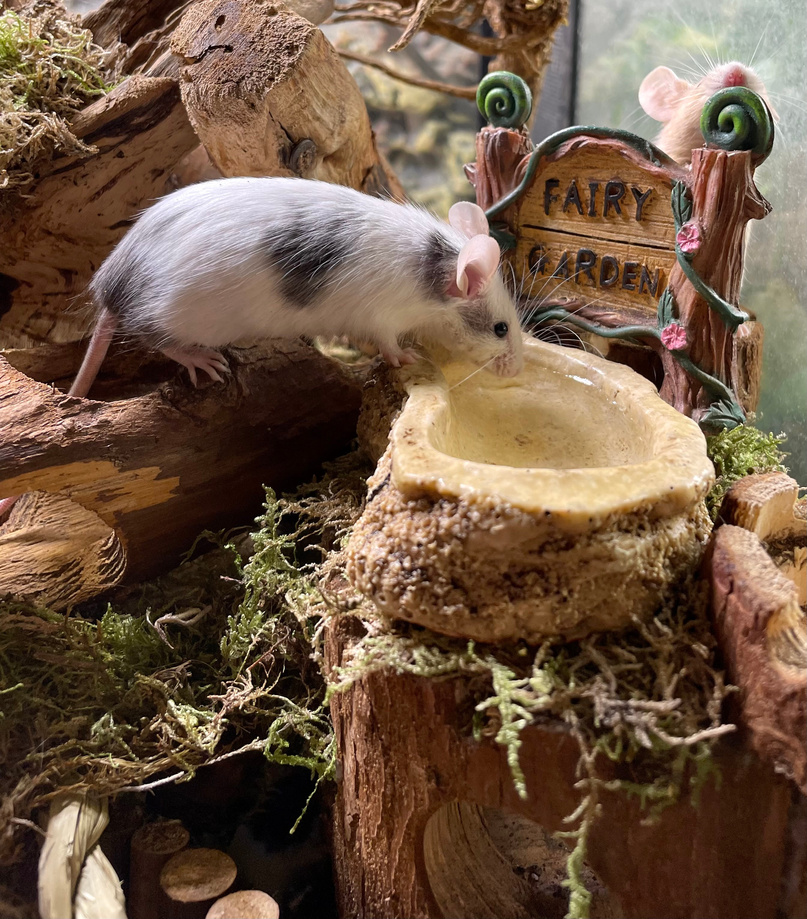





+ bioactive mouse terrariums
+ mouse husbandry
Etsy


Bioactive terrariums
Inside our natural enclosures:
Bioactive terrariums
Inside our natural enclosures:
Organic Sphagnum moss (terrarium moss)
*Avoid the artificially dyed "craft" moss.
Organic coconut fiber & natural potting soil (with no additives or fertilizers)
Compressed coco blocks are usually cheaper. Please make sure the soil is completely dry before adding it to your tank. If you put wet material throughout the entire enclosure; the mice will not be able to escape the cold. This can trigger torpor, which can be fatal.
If you're doing a living bioactive tank, it's crucial to keep parts of the soil damp so the cleanup crew has moisture. Only dampen one side of your enclosure so the mice are able to stay dry.
Wood that is safe for rabbits is safe for mice.
*I personally use cottonwood, cork, driftwood perches (for birds), manzanita, and mulberry.
If you go foraging for materials, be sure to avoid neighborhoods, parks, or anywhere you suspect the potential usage of insecticides/pesticides.
How To Process Leaf Litter:
Thoroughly rinse the leaves in a pot of water, strain & repeat. Bring water to a boil and steep leaves for 5 minutes. Once they have dried, you can add them to your enclosure.
Getting branches ready for your mice.
- Set oven to 250-300°F
- Place the branch in the oven and bake for 2-4 hours (depending on size) Check frequently.
please DO NOT leave anything baking in an oven unattended at any time! Even low temperatures have the potential to cause a fire!
ne


Clean up crew
Minimize deep cleaning your tank by using beneficial insects and micro-fauna like Isopods, Springtails, and Millipedes that help to consume and break down the decaying organic matter (mold, animal feces, etc) that can build up in your pet's enclosure.
You can purchase these helpful critters online. Read more about them here:

Here's an excellent resource on safe wood


- Oxbow Essentials Mouse & Young Rat Food (or)
- Mazuri Mouse & Rat Food
- Tiny Friends Farm Reggie Rat and Mimi Mouse Tasty Mix (mix with blocks)
My mice are also offered fruits, vegetables, insects, chicken, eggs, pasta noodles, etc.
I like to give them a variety of options.
do not feed
onions, lettuce, walnuts, raw beans, rhubarbs, raisins/grapes
5-gallon tank = 1 mouse
10-gallon tank = 3 mice
15-gallon tank = 4 mice
20-gallon tank = 5 mice
25-gallon tank = 6 mice



Mice are communal animals with highly organized hierarchical systems. This is why it's never advised to house a mouse by itself.
*Only unaltered males can
be housed alone.



Mice historically have a bad rap. A lot of which is untrue! Contrary to popular belief, mice are very tidy little creatures. They are opportunists; meaning they will appear if there is a plentiful resource available. And if there are people around- there's definitely food, water & nesting materials!